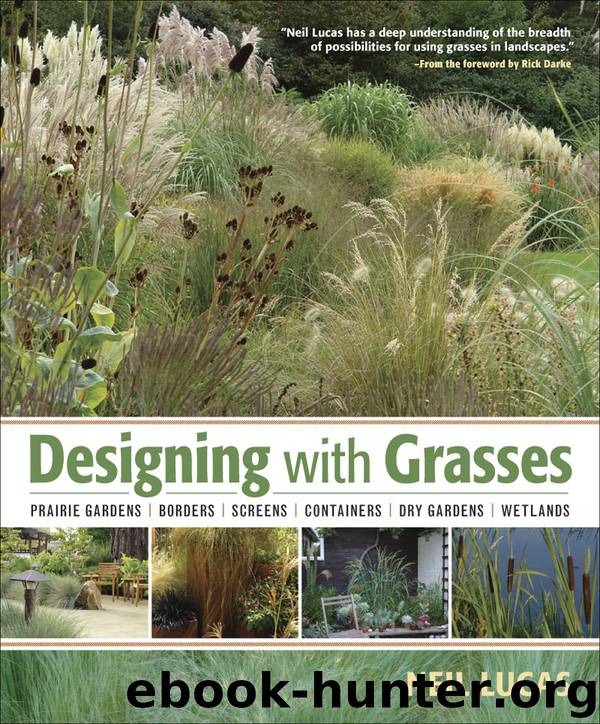Designing with Grasses by Neil Lucas

Author:Neil Lucas
Language: eng
Format: epub
Publisher: Timber Press
Published: 2011-03-04T16:00:00+00:00
Ampelodesmos mauritanicus. Photograph courtesy of Dianna Jazwinski.
Andropogon gerardii. Photograph courtesy of Dianna Jazwinski.
‘New Wave’. A striking selection from seed, with strong reddish stems that are distinctly upright, holding the flowers quite clear of purple-tinged clumps of green foliage. To 1.8 m (6 ft.).
Andropogon glomeratus
syn Andropogon virginicus var. abbreviatus.
BUSHY BEARDGRASS
Naturally occurs in wet places like marshes and bogs, with relatively short though still upright flower stems that are noticeably fluffy when in seed. The stiff stems of A. g. var. scabriglumis are a little taller; limited to warmer areas, it is not quite as hardy. Both make excellent garden plants, especially in prairie or meadow plantings, preferring full sun. From North America. To 90 cm (3 ft.). Z5.
Andropogon virginicus
BROOMSEDGE
Tough and adaptable, occurring over a wide area and under greatly differing soil conditions. Especially valuable when used en masse such as in meadows where its bright autumnal and winter colourations, ranging from almost bright orange to dull copper, create the most striking of effects. At its best in poor soils and full sun. From North America. To 90 cm (3 ft.). Z3.
Andropogon virginicus var. glaucus
CHALKY BLUESTEM
Less cold-hardy but more heat tolerant than A. v., this geographically limited variety is distinct for its glaucous blue summer foliage that has given rise to several cultivars with more intense blue colourations. Especially useful in drought-prone areas in full sun. From the southern U.S. To 90 cm (3 ft.). Z7.
Anemanthele
Native to both North and South Islands of New Zealand from hilltop to sea level, this genus comprises just one species of ornamental cool-season evergreen grass—long known to gardeners as Stipa arundinacea.
Anemanthele lessoniana
syn Stipa arundinacea, Oryzopsis lessoniana.
PHEASANT TAIL, WIND GRASS
A most graceful and useful clump-forming evergreen that happily tolerates a range of conditions from full sun to fairly deep shade with apparent equanimity, even surviving under the canopy of established trees in the driest of conditions. Happy also in most soils except wet, this is one of the very few true grasses to accept such wide-ranging sunlight levels and as a result is much valued by gardeners, especially for dry shade. Forming extremely graceful mounds of leaves gently cascading from a central tight clump that does not split easily, the leaves follow a constantly changing pattern of greens, tans, oranges and reds, though in deepest shade they tend to remain green. Easy to establish. Masses of tiny pinkish red flowers on lax stems are produced profusely enough to cover the plant in a gauzy cascade of pink. Will re-seed but does not appear to be ecologically invasive. To 75 cm (2½ft.). Z8.
‘Gold Hue’. A seldom-seen selected form, displaying a lighter yellowy gold foliage colour for a much longer period of time.
Aristida
THREE AWN
A very large and wide-ranging group of warm-season deciduous, mostly clump-forming bunch grasses, often a major constituent of dry grasslands such as savannah in North America, Africa, Asia and Australasia.
Aristida purpurea
PURPLE THREE AWN
A common element of Californian dry grasslands, named for its flowers which are produced in some profusion over a long period. Can provide a
Download
This site does not store any files on its server. We only index and link to content provided by other sites. Please contact the content providers to delete copyright contents if any and email us, we'll remove relevant links or contents immediately.
Turbulence by E. J. Noyes(7983)
The Thirst by Nesbo Jo(6882)
Gerald's Game by Stephen King(4614)
Be in a Treehouse by Pete Nelson(4002)
Marijuana Grower's Handbook by Ed Rosenthal(3648)
The Sprouting Book by Ann Wigmore(3564)
The Red Files by Lee Winter(3393)
The Remains of the Day by Kazuo Ishiguro(3349)
Sharp Objects: A Novel by Gillian Flynn(2988)
Christian (The Protectors Book 1) by L. Ann Marie(2670)
Organic Mushroom Farming and Mycoremediation by Tradd Cotter(2664)
The Culinary Herbal by Susan Belsinger(2454)
Stone Building by Kevin Gardner(2375)
The Starter Garden Handbook by Alice Mary Alvrez(2311)
Lilac Girls by Martha Hall Kelly(2275)
The Unlikely Pilgrimage of Harold Fry by Rachel Joyce(2243)
The Lean Farm Guide to Growing Vegetables: More In-Depth Lean Techniques for Efficient Organic Production by Ben Hartman(2107)
Urban Farming by Thomas Fox(2084)
Backyard Woodland by Josh VanBrakle(1911)
